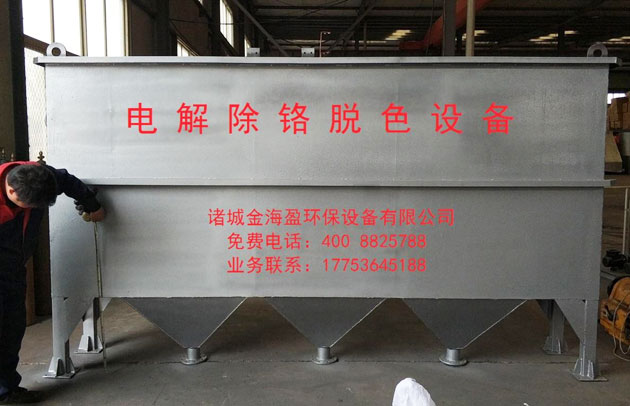PRODUCT
Dihui Environmental Protection
- contacts:Mr. Zhang
- Tel:177-5364-5188
- Add:No. 118, Houhuangtuan Village, Mizhou East Road, Mizhou Street, Zhucheng City, Weifang City, Shandong Province, 178 meters north of Houhuangtuan Industrial Park

1、 Introduction to electrolytic decolorization flocculation device:
The electrolytic cell is equipped with electrode plates, which are generally made of ordinary steel plates. There is a standard distance between the positive and negative electrodes, as well as between the plates, to ensure minimal energy consumption and facilitate installation, operation, and maintenance. Electrolytic cells are divided into two types: unipolar and bipolar, based on the method of connecting the power supply to the electrode plates. The characteristic of a bipolar electrode electrolytic cell is that the middle electrode generates bipolarity through electrostatic induction. This type of electrolytic cell has simpler electrode connections, safer operation, and significantly reduced power consumption compared to unipolar electrode electrolytic cells. The anode is connected to the anode of the rectifier, and the cathode is connected to the cathode of the rectifier. After being powered on, under the action of an external electric field, the anode loses electrons and undergoes an oxidation reaction, while the cathode gains electrons and undergoes a reduction reaction.
Wastewater flows through the electrolytic cell and serves as the electrolyte, undergoing oxidation and reduction reactions at the anode and cathode, respectively, to remove harmful substances. This type of oxidation or reduction reaction directly on the electrode is called a primary reaction. Taking cyanide containing wastewater as an example, its electrochemical oxidation process on the anode surface is as follows:
CN-+2OH--2e─→CNO-+H2O
2CNO-+4OH--6e─→2CO2↑+N2↑+2H2O Cyanide is converted into non-toxic and stable inorganic substances.
Electrochemical treatment of wastewater can also adopt indirect oxidation and indirect reduction methods, which use electrode oxidation and reduction products to chemically react with harmful substances in the wastewater, generating insoluble precipitates to separate and remove harmful substances.
2、 The advantages of using electrolysis to treat wastewater:
Using low-voltage DC power supply, there is no need to consume a large amount of chemicals; Operated at room temperature and pressure, easy to manage; If the concentration of pollutants in wastewater changes, the stability of the effluent quality can be ensured by adjusting the voltage and current; The processing device occupies a small area. However, when dealing with a large amount of wastewater, there is a high consumption of electricity and electrode metals, and the separated precipitate material is difficult to treat and utilize.
3、 Application of electrolysis method
The electrolysis method is mainly used to treat dyeing wastewater, chromium containing wastewater, and cyanide containing wastewater. In addition, it is also used to remove heavy metal ions, oil, and suspended solids from wastewater; It can also condense and adsorb dye molecules in colloidal or dissolved state in wastewater, while oxidation-reduction can destroy chromophores and achieve decolorization effect. Experimental research is also being conducted on the use of electrolysis to treat wastewater containing phenol, cadmium, sulfur, organic phosphorus, and food industry wastewater.
4、 Equipment photo:




